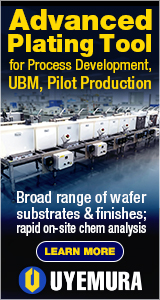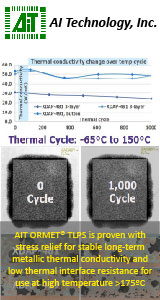|

|
|
| Ask the Experts | |||||||
|
|||||||
|
March 6, 2018 - Updated March 22, 2010 - Originally Posted Soldering Lead-free Components with Tin-lead SolderCan we solder lead free, 1500 pin BGA with Leaded (SnPb) solder? This is for a non RoHS compliant application. Are there precautions we should be aware of? A. V. |
|||||||
| Expert Panel Responses | |||||||
|
For a Pb-free ball & Sn-Pb paste, from a reliability standpoint - it is better to completely melt the Pb-free ball and have a homogenous joint.
Technical Manager - Europe Indium Corp. Currently with Indium Corporation and responsible for technology programs and technical support for customers in Europe. Over 15 yrs experience in SMT, Power, Thermal & Semiconductor Applications. Masters Degree in Industrial Engg, State University of New York-Binghamton.
With a device of this size and complexity, the issue will be thermal consistency across all the I/O positions. In a typical reflow process where the transfer medium is gas [air or N2] the outer leads of this device will receive heat quickly and effectively, the inner leads will be starved until the whole PCB is able to conduct heat into the inner areas of the array [ it is impossible for the gas mechanism to reach under the device.] The result is differing thermal profiles from the outer edges to the centre of the device, this in turn may affect the joint structure, integrity and longer term reliability. The recommendation would be to use a Vapor Phase System which uses an inert fluid as the basis for thermal transfer. As the fluid is boiled It creates vapor and as the vapor condenses onto the PCB it transfers energy [heat] to the PCB. The efficiency factor over gaseous systems is ~10x and given the natural capillary action of a fluid it is able to move in under the array device and come into contact with very I/O, all 1500, and conduct heat to each equally quickly and effectively, stabilizing the thermal profile across the device ensuring the integrity of every joint on the device.
CEO ATEK llc Allen Duck is a 20-year Electronics Industry veteran with Global experience in multiple fields of technology and management. He started A-Tek in 2006 to provide a sales and service channel for international equipment companies wishing to offer value based solutions to USA companies.
Mixing of lead free solder and tin/lead solder balls will result in an alloy somewhere in between and you should be aware that this will have different properties to both alloys. Also, if the alloys do not fully mix then you may be left with a non-homogenous structure which could cause premature failure. They must be allowed sufficient time above liquidus to fully mix. At the end of the day the drivers are the end use of the product and whether it needs to be truly lead free. If it is in a critical application with long life expectation or severe environmental conditions I would not recommend it. You could always have the solder balls changed to lead free by a specialised rework company if need be.
Principal Engineer - CMA Lab BAE Systems Bryan Kerr has 35 years experience in providing technical support to PEC assembly manufacturing. His experience ranges from analysis of materials and components to troubleshooting and optimizing, selecting reflow, cleaning, coating and other associated processes.
There should be no reliability issue with the soldering application that you are suggesting. The use of Sn63/Pb37 solder paste for lead-free BGAs is not all that uncommon. It is recommended to reach a higher peak temperature than you would normally consider with Sn63/Pb37 solder paste. The reason for this is that you want to insure that the Lead-free balls on the BGA melt so that proper collapse can occur. This generally means achieving a reflow profile with a peak temperature in the neighborhood of ~225C on the BGA. (The melt point of the SAC305 balls is 217-219C.) This means that the peak temperature on the lower-mass components may reach 230C or above.
General Manager - Electronic Assembly Americas DEK International Mr. Smith has been supporting customers in the electronics assembly industry since 1994. His expertise is focused on solder paste printing and reducing soldering defects. He holds a BS in Chemical Engineering and an MBA in Marketing. He has authored several papers in trade magazines and at industry conferences. He is an SMTA Certified Process Engineer.
Rohs PCBs are made of the different materials. It is specially design for rohs component soldering. The reflow profile of rohs soldering and non rohs soldering are different. Since it is BGA soldering so not recomend for non rohs component on rohs PCB.
Quality Engineer Matrix Telecom Solution P Ltd Sandip Thakor has 9 years of experience in electronics industry specializing in soldering technology. Thakor has experience in lead free installation, process optimization and developing quality standards.
It is true that a homogenous alloy mix must beachieved. If you have lead-rich areas in the resultant solder joint, you willend up with premature solder joint failures. However, there are other factorsyou need to think about as well. Consider; when soldering the Pb-free BGA atthe higher temperature, the other components on the non-RoHS CCA may not beable to withstand those higher temperatures. If they are damaged you cannotexpect to return those parts to the vendor for credit, as they will onlywarranty their components when soldered at the temperature that they are ratedfor, and believe me, they know when they have been damaged from too hot of areflow profile. Secondly, consider the fact that you do not absolutely NEED toprint solder paste for this part; it will solder just as well if you simply puta thin veneer of tacky flux onto the pwb pads and place the BGA last of all. The tacky flux will usually hold the part in place just fine through reflow,and then you do not need to worry about whether the joints are homogenous, ornot. Contact me for the details on how to solder withoutpaste, as the process ends up giving you a much more reliable finished product,and not just because of the solder joints alone.
Advanced Engineer/Scientist General Dynamics Richard D. Stadem is an advanced engineer/scientist for General Dynamics and is also a consulting engineer for other companies. He has 38 years of engineering experience having worked for Honeywell, ADC, Pemstar (now Benchmark), Analog Technologies, and General Dynamics.
Depending on the volume you might use an alternate methodto solder that component. A BGA rework station can place the componentaccurately and the localized reflow can provide appropriate heat to all the BGAsolder balls regardless of them being to the outside or the inside area of thecomponent's body. Another solution to avoid mixing the different solderpaste compositions is to dispense flux only on the pads after paste deposition,pick, place and reflow. Now for the reflow temperature there are alwaystrade-offs that you will have to do. The population on the board is extremelyimportant as fine pitch components can exhibit reflow issue due to elevated temperaturesneeded for lead-free materials.
Engineering and Operations Management Independent Consultant Georgian Simion is an independent consultant with 20+ years in electronics manufacturing engineering and operations.
Contact me at georgiansimion@yahoo.com. Reader Comment
Yes, you can mount lead free BGA with Non-ROHS process, we call it mixed process. Our PCBA also have such situation, we increase the reflow profile about 10 degrees compare with normal Non-ROHS, to make sure peak temperature between 220~230 degrees, and perform X-ray inspection for each BGA. For the detail profile, you can check with your solder paste supplier, they should can give you some suggestions.
Richard Ji, K&S
|
|||||||
| Submit A Comment | |||||||
|
Comments are reviewed prior to posting. You must include your full name to have your comments posted. We will not post your email address. |
|
Free Newsletter Subscription
Circuitnet is built for professionals who bear the responsibility of looking ahead, imagining the future, and preparing for it. Insert Your Email Address |
|

|








